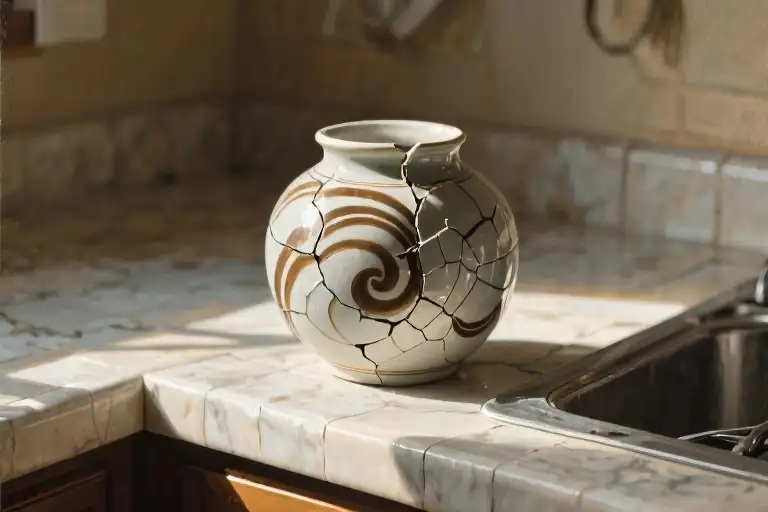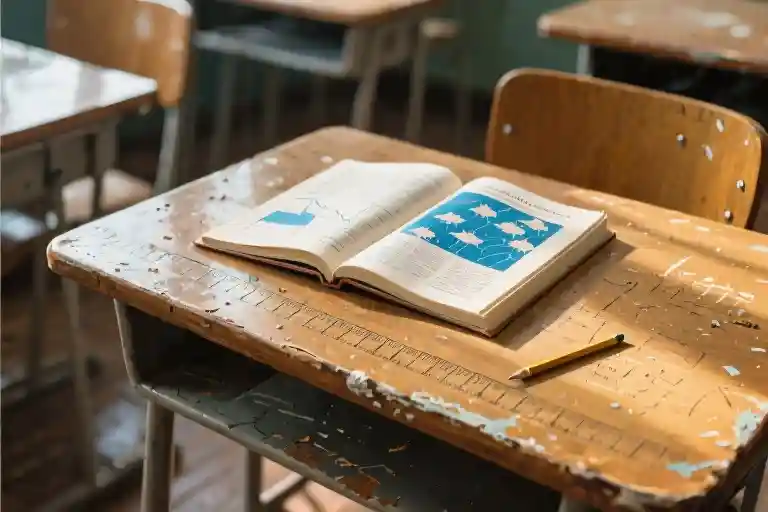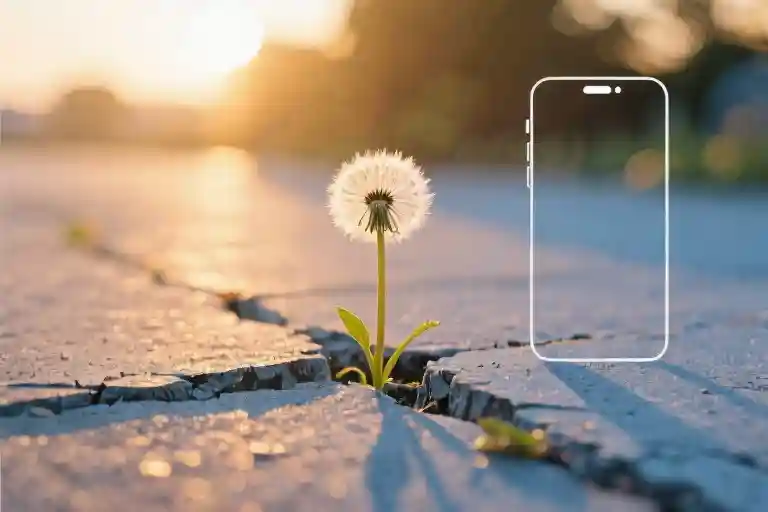“You sure you don’t want to smash it?” Her fingers hovered over the vase’s glaze – that sable swirl I once traced with wedding-band fingers, back when porcelain still felt like promise. The decorative vase caught afternoon light in its curves, throwing fractured shadows across the kitchen counter we’d chosen together twelve years ago.
My thumb found the familiar dip in the ceramic where the glaze thickened, an accidental imperfection we’d laughed about when unwrapping this wedding gift. Now it felt like braille spelling out memories I couldn’t erase. The offer hung between us like the scent of drying paint – that cheap white latex I’d used for years trying to cover hairline cracks in our walls.
‘Maybe I would like to smash it,’ I admitted. The words tasted metallic, like biting a stop sign in winter. But destruction had never been my language. Not when painting over shadows proved simpler, not when resentment could be tucked away like mismatched trinkets on forgotten shelves.
Her nail tapped the vase’s rim, producing a clear note that vibrated through my molars. That sound had once meant dinner parties and fresh peonies. Now it just measured the distance between what objects remember and what people choose to forget.
I watched sunlight climb the vase’s spiral pattern – that hypnotic sable swirl we’d both pretended not to see resembled the storm system on our wedding weather radar. Twelve years of fingerprints had polished the ceramic to a dull sheen, like the patina on my abandoned ring.
‘Take it,’ I said, withdrawing my hand. The counter felt suddenly colder where my palm had been. ‘Things don’t need more smashing. Just someone who’ll care for them properly.’
Outside, a dog barked three streets over – that same ragged sound that always seeped through our bedroom window at dawn. I wondered if it would follow me to the new neighborhood, this phantom hunger I’d been feeding with scraps of nostalgia.
The vase sat between us, its shadow stretching long across the linoleum we’d installed during that optimistic summer of 2011. How many layers of paint would it take to cover that silhouette? I already knew the answer from painting over the water stain above our shower – some marks bleed through every coat.
She wrapped both hands around the vase’s belly, the way one might steady a lifeboat in rough seas. I flexed my empty fingers, feeling the ghost weight of all we’d carried. The front door stood ajar behind me, revealing a sliver of moving van and the new keys burning in my pocket.
Twelve years is long enough to learn this: you can’t hate a memory into leaving. But you can stop feeding it your best china.
The Shadows Beneath the Paint
Midnight found me crouched on the hardwood floor, a half-empty can of discount white paint between my knees. The bristles of my brush scraped against the baseboard in uneven strokes, each pass attempting to erase the hairline fractures radiating from that November evening when the vase had shattered against the wall. Twelve years of these clandestine painting sessions had turned our home into a palimpsest of poorly concealed damage – layer upon layer of matte white obscuring, but never truly erasing.
The ritual always followed the same pattern:
- Discover new cracks after particularly tense silences
- Wait for the house to fall still
- Paint by the blue light of my phone screen
That night, something shifted. As I watched the fresh coat dry under the dim glow, the wall began to breathe. The painted-over shadows pulsed like slow-moving ink in water, forming shapes no brush could cover. A silhouette of our first dance. The outline of a suitcase by the door. The ghost of a dog that never was but always seemed to linger at the threshold, waiting for scraps of affection I could no longer spare.
Funny how trauma calcifies into routine. I’d spent 4,380 days (I’d counted) performing this alchemy – transforming grief into home improvement. Enough paint to fill a swimming pool. Enough hours to earn a PhD in avoidance. The math never comforted me; it only proved how expertly we can measure our own suffering without ever addressing its source.
Three truths became clear as the shadows rippled:
- Paint is temporary – it yellows, chips, reveals
- Shadows are persistent – they migrate, transform, outlast
- Dogs keep returning to houses where they’ve been fed, even poorly
The can slipped from my hands, rolling across the uneven planks where we’d once imagined laying down a nursery. That sound – the hollow metallic clatter – became my awakening. Some stains aren’t meant to be covered. Some hungers shouldn’t be fed. And no amount of white paint can recreate innocence once it’s lost.
Key Metaphors Explained:
- The Paint: Our compulsive attempts to ‘fix’ surface appearances while ignoring structural damage
- The Shadows: Emotional truths that persist despite our efforts to suppress them
- The Dog: The lingering emotional needs we half-heartedly address but never properly nurture
As dawn crept through the blinds, I left the brush in the paint can like a flag planted at the scene of surrender. The walls would keep their shadows. The dog would need to find another door. And I – I needed to stop pretending home improvement could stand in for heart repair.
The Hungry Dog at the Door
The thin shadow had been waiting by the porch for years. Not a real dog, of course – just the kind that follows you home from emotional places and refuses to leave no matter how many times you shoo it away. It would materialize whenever I opened the refrigerator at 2am, or when I absentmindedly traced the glaze lines on that damned vase. Always there, ribs showing through its spectral fur, eyes too bright with expectation.
Can’t keep throwing scraps to dogs expecting they won’t follow. The realization came while watching actual neighborhood strays fight over a pizza crust. That’s what I’d been doing for twelve years – tossing emotional leftovers at something that would never be satisfied. Not the marriage, not the house, certainly not myself. The more you feed strays, the more they multiply. Soon you’ve got a whole pack of hungry ghosts scratching at your doors.
There’s a particular madness in trying to nourish what should have starved long ago. Like repainting walls where the shadows won’t take the hint. That dog – my dog – had learned all my routines. It knew I’d crumble when the microwave clock showed our old anniversary date. Recognized the exact pitch of my sigh when sorting through mismatched silverware. These weren’t memories anymore; they were trained behaviors, like Pavlov’s drooling experiment with better interior design.
The magic trick no one tells you about emotional healing? You can’t hate a memory into leaving you alone. Anger just makes better dog food – richer, more aromatic. That vase could have shattered into a thousand pieces and the dog would’ve just licked up the shards, tail wagging. Some part of me wanted to see it bleed, but you can’t wound a shadow that way.
So I stopped carrying treats in my pockets. No more midnight snacks of ‘what if’ and ‘if only.’ The dog got skinnier. The shadows grew fainter. And when I finally walked away with my two bags, I didn’t look back to see if it followed. Some hungers aren’t yours to satisfy.
Twelve years is long enough to learn this: You can’t starve out the past, but you can stop inviting it to dinner. The real magic happens when you stop believing in the dog at all.
The Temperature of Doors
The old doorknob left rust stains on my palm – those stubborn orange blooms that no amount of scrubbing could erase. For twelve years, my fingers had memorized its jagged texture, the way it resisted turning unless you lifted slightly upward with that secret pressure point known only to long-term residents. That door had witnessed too many exits: grocery runs that turned into all-night absences, slammed departures after fights about whose turn it was to repaint the bedroom, and finally, that last quiet click when I walked out with two suitcases and no intention of returning.
Now my knuckles hover before new wood, the brass knob gleaming like a freshly minted coin. No fingerprints yet, no history. I press my thumb against its smooth surface and feel the shocking coldness of untouched metal, so different from the sun-warmed patina of our – no, her – front door. This chill is exhilarating, the kind that makes you gasp when jumping into a mountain lake. My fingers don’t recognize this motion – no lifting, no jiggling, just a clean clockwise turn that sounds like a key unlocking a safe deposit box.
When the door swings inward, light pours over the threshold in a wide golden puddle. I step into an emptiness so vast it echoes. No furniture ghosts here, no rectangular outlines on walls where pictures used to hang. Just four blank walls holding their breath, hardwood floors polished to a mirror shine, and windows so clear they seem like openings into another dimension. The afternoon sun cuts diagonal stripes across the floor, illuminating dust motes dancing in what will soon become my personal atmosphere.
I walk barefoot to the center of this emptiness, my footsteps producing satisfying hollow knocks. Setting down my bags creates the first anchor points in this sea of possibility. One near the east window where I’ll place my reading chair, the other by what will become my writing desk. Already I can see where bookshelves will grow like crystalline structures along the north wall, how a rug will bloom beneath the coffee table like a textile garden.
For now, I stand still and let the space calibrate around me. The air smells of citrus-scented wood soap and the faintest hint of lavender from the sachets the previous owner left in the closet. When I exhale slowly, the sound travels uninterrupted to the far wall and returns to me, transformed. This is what freedom sounds like – not silence, but resonance.
My shoulders drop two inches as the house accepts my weight. The new doorknob waits patiently behind me, already losing its initial chill to the warmth of my touch. Somewhere across town, a vase with sable swirls sits on a shelf, no longer my responsibility. Here, there are only wide-open afternoons and doors that open without hesitation.
The Ritual of Breathing
The new doorknob turned cold under my palm, its metallic smoothness unfamiliar yet comforting. As I pushed the door open, the hinges sighed – not the protesting creak of our old house, but a quiet exhale, as if the space itself had been waiting to breathe with me.
Three steps in, I set down my bags. The sound of fabric settling on hardwood echoed through the empty rooms. Standing in the center of that sunlit rectangle, I began the conscious ritual:
First breath – in through the nose, tasting the faint citrus scent of cleaning products mixed with the chalky promise of fresh drywall. My shoulders dropped two inches as the air filled my lungs, pressing against ribs that had forgotten how to expand fully.
Second breath – deeper now, hearing the whisper of air move through unfurnished spaces. The acoustics surprised me; this empty room carried sound differently than the cluttered apartment I’d left. Each inhalation became a conversation with the architecture.
Third breath – eyes closed, feeling the late afternoon sun paint warmth across my eyelids. The light here didn’t filter through stained-glass votives or patterned curtains. It fell unobstructed, pooling on the floorboards like liquid gold.
With each exhale, I imagined releasing fragments of the past – not violently, not like shattering porcelain against concrete, but gently, the way one might open their hands to let dandelion seeds catch the wind. The space absorbed them without judgment.
I’d read somewhere that echoes last longer in empty rooms. But as I stood listening to my own breathing reverberate, I realized this wasn’t true. The clean walls didn’t cling to sound; they let it travel freely until it dissipated naturally. A revelation so simple it ached – some things don’t need to be destroyed to be released. They just need adequate space to fade.
My fingers found the smooth surface of my phone, thumb hovering over the notes app. A question floated up, unbidden but insistent: What object would you let go today? Not through destruction, not with ceremony, but simply by allowing it to occupy different space.
Perhaps you have a vase gathering dust on a shelf. Or a sweater folded too carefully in a drawer. Maybe it’s a book whose spine you can’t bring yourself to crack open. Whatever shape your emotional object takes, consider this permission: you don’t have to break it to be free of it. Sometimes the bravest act is setting something down in an empty room and walking away while it’s still whole.
If this resonates, I’m exploring more stories about objects and emotional healing in my upcoming novel and on Substack. Your stories are welcome there too – what’s one thing you’ve released without destruction?





